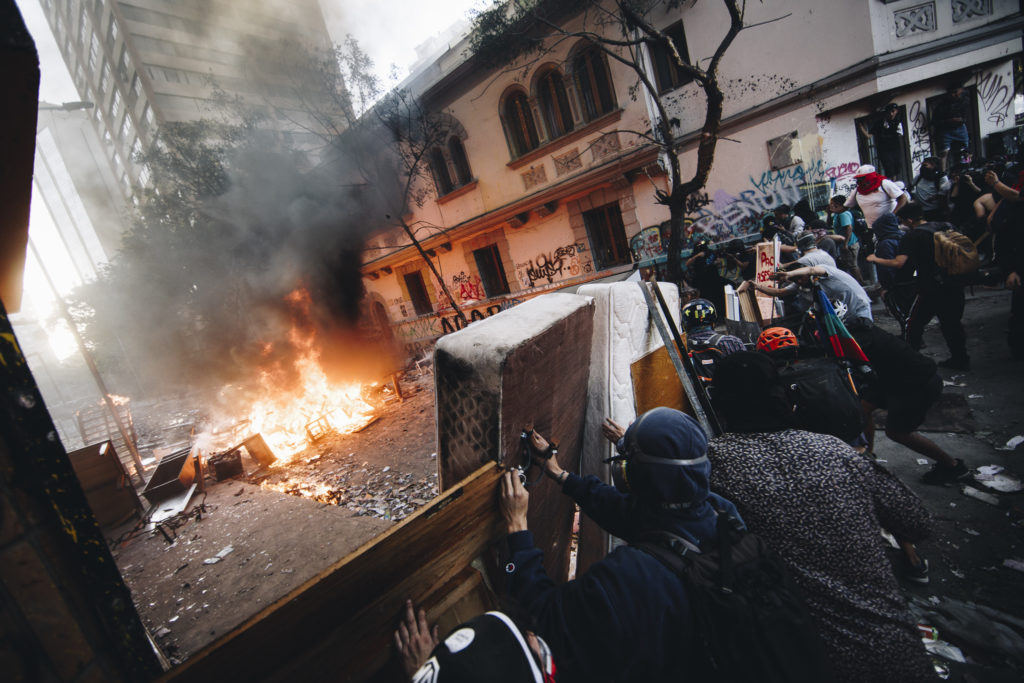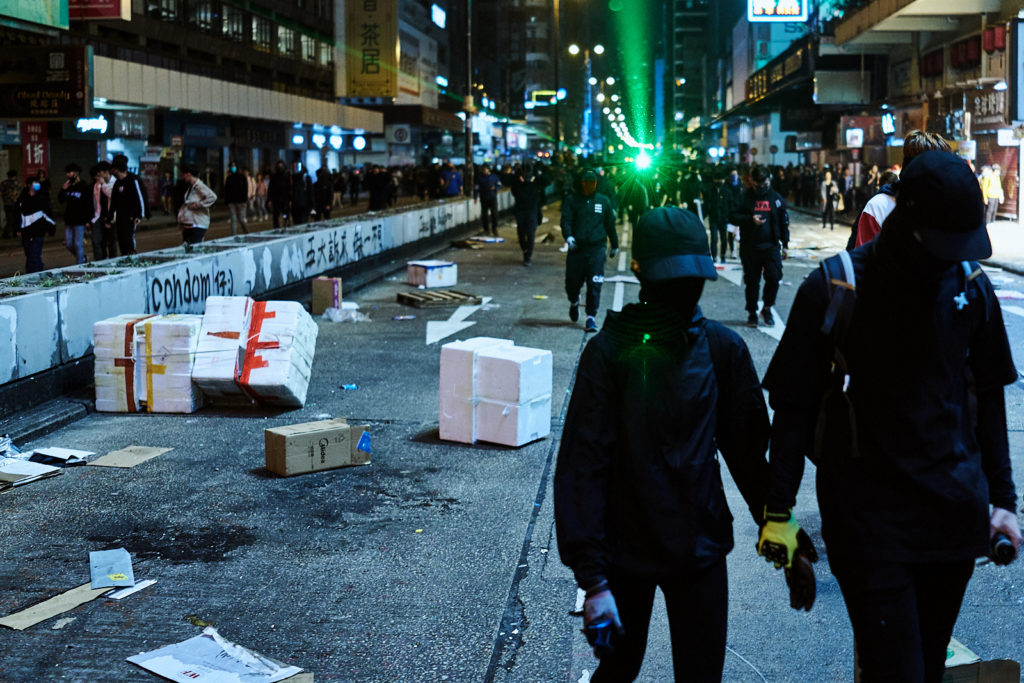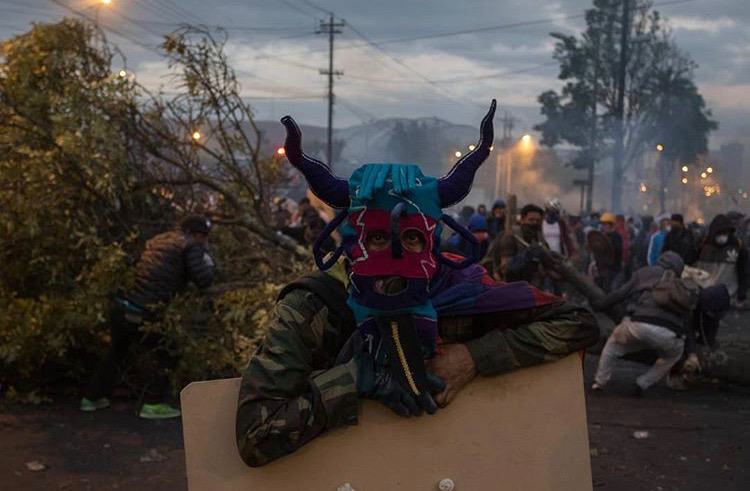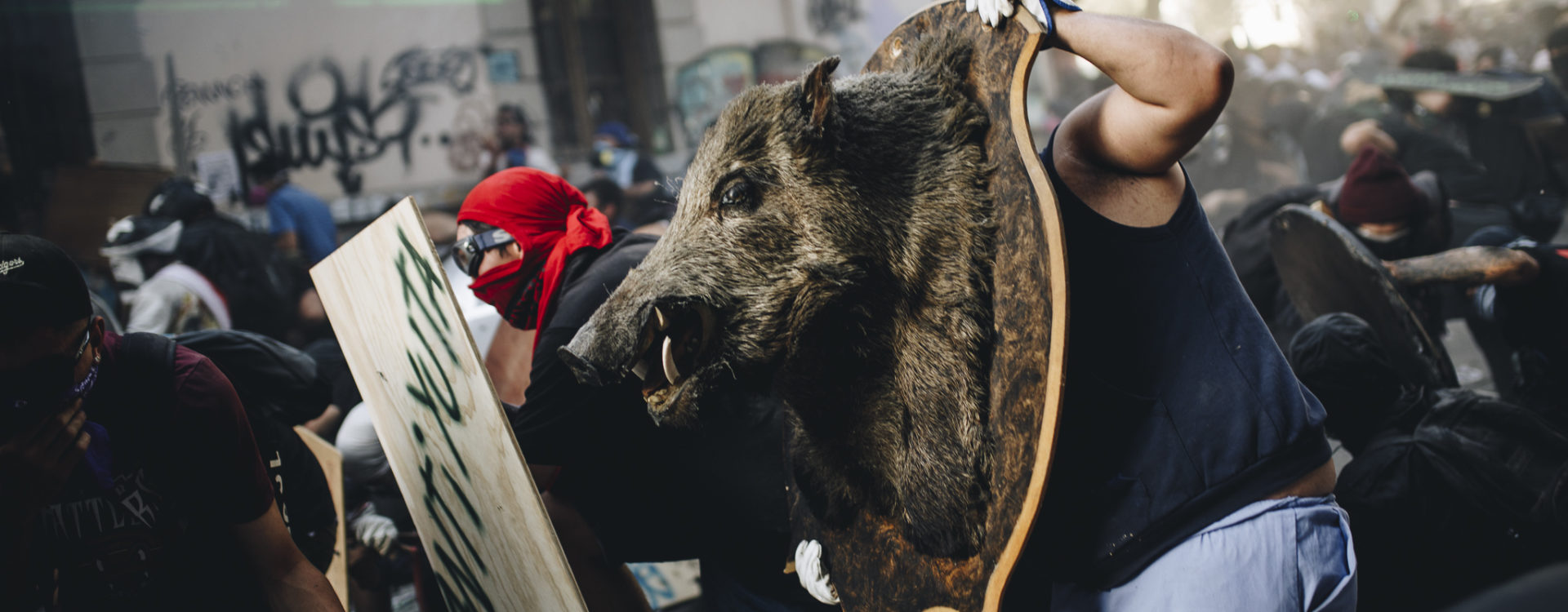All of them means all of them.
It is a strange time to be an English speaker, and particularly the sort that peers out from the United Kingdom or the United States. Each has been a global colonizer both military and economic, delivering accumulation at a global scale. But it is not just that the UK and US have been lords of their own long centuries; they are not two of many. They are the only two exemplars of empire at its most absolute, coordinating free and unfree labor, exploitation and extraction, into planetary regimes of settler capitalism. Without falling into endless debates about when capitalism truly began, it is easy to say that these two nations are together unique to its history.
What do these nations share now, in this very moment, in this short season measured against their long centuries? Over the course of 2019, both exhibited a fascination with and reaction against what is being called socialism, embodied in the electoral projects of Jeremy Corbyn and Bernie Sanders respectively. The former project came a cropper as the year ended, with Corbyn’s decisive defeat in a general election against nationalist buffoon Boris Johnson; the UK’s energized left has barely paused for the wringing of hands, pivoting directly toward politicking over the next party leader, and now openly seeking a Sanders of their own.
It seems tactless to debate whether this ballot boxing is really socialism or not. Perhaps it isn’t, if one holds to some orthodoxy about workers’ seizure of the means of production or the “lower stage of communism” or the like. Or perhaps it is, and that is a damning verdict on socialism itself. It is certainly fair to say that we have seen the most socialist candidates within the political mainstream since the collapse of the postwar compromise, maybe longer. The backward-looking character is most evident in the most forward-looking moment: the ambitious Green New Deal turns with great seriousness of purpose toward the catastrophe of the future by brandishing the policy weapons of the past, an eco-Keynesian apparatus that will restore the stable labor contract
of the Long Boom, driving new investments and green jobs with the engine of deficit spending.
The post-Soviet nations, discovering not the promised freedoms but oligarchy and collapse, suffered from that sense of a lost Soviet past termed ostalgie. In that tradition, the visions of socialism currently entrancing the UK and US left convey the accurate sense that the current path leads nowhere good. It should go without saying that these backward-looking politics are posed as progressive visions, even as faith in progress seems at this late date misplaced. Also needless to say that such visions are possible only in the core, in the places with long booms to look back on. And finally, that this nostalgia always means effacing the extent to which the imperial welfare state has always depended on immiseration domestic and exported, on exploitation, dispossession, and despoliation that remain out of sight and out of mind, is equally self-evident. And so, finally, it cannot be surprising that the distributed disorder of 2019, when taken as a global whole, forms at once a unity and contradiction. As the two great empires collapse political life into socialist electoral hopes, matters proceed quite differently at empire’s peripheries, where Santiago burns, Beirut burns, Hong Kong burns, Port-au-Prince burns, Quito burns.
The Two Genres
They look mostly like riots, the insurgencies of 2019, and often develop into broader, even revolutionary conditions; they drop governments regularly, though not always toward more emancipatory situations. There are a lot of them.
It would seem that there are two methods for surveying the specific instances within the great panorama, some of which burst into view quite suddenly, some of which preceded the year but were characterized by the persistence if not the intensification of ongoing antagonisms. The first would be to list them all with a note or two about each; the other to find some coordinating theme which can unify the year. Inductive or deductive, Parmenides or Heraclitus. Things or the relations among things, as ever.

But neither of these approaches seems to suffice. There are too many items to spread out simply like jewels upon a dark cloth, stars in the night sky. One would be bound to miss a few, and more importantly, it would be impossible to make much meaning, except, perhaps, for the sense of too much, Algeria, Argentina, Bolivia, Canada by which we mean the Wet’suwet’en Nation, Chile, Colombia, Ecuador, Egypt, Guyana, Guatemala, Haiti, Honduras, Hong Kong, India by which we also mean Kashmir, Iran, Iraq, Kazakhstan, Lebanon, Malta, Mexico, Puerto Rico, Russia, Spain or do we mean Catalonia, Sudan, Uruguay . . .
Even to make this list, inevitably incomplete, is to invoke some assumptions about what counts. Mostly we count by nation not neighborhood. We make unstated assumptions about intensity of conflict. We are more beholden to the media than we would like to believe, taking note of events when daily immiseration and patient resistance leaps dramatically into the news cycle. And — why not the street gatherings in Sardinia? Why not give the United States more credit beyond Puerto Rico? What of the ZAD L’Amassada? And so on. But the incompleteness is the point, the truth of it all: the experience of a surplus that can’t be captured according to the usual protocols of perception, a great disorder which, if it cannot be captured by spreadsheets, thereby presents the possibility that the global party of order faces fracture.
One could try to group things geographically, to suggest that we can glimpse in Latin America a continuation of the pink tide, or its resurrection against the counterrevolutions that it first summoned; perhaps we could squint and see a renascence of challenges in and around the Mashriq? Neither of these is a clear vision, and the rest of the globe will not be organized so easily.
Alternately, we could proceed by genealogy and chronology, looking back to the cauldron of 2010–11, the movement of the squares, Occupy, the Arab Spring. Certainly writers are now ever ready to call any leap of regional uprisings from nation to nation The Something Spring, just as we have learned to call any newsworthy corruption Somethinggate. But there is no single cause, or theme, or tactic, that can gather together even a majority of the actual cases while telling us something we didn’t already know. One can of course dial down the particularities of each until a spectrumatic explanation for all emerges, but by that point the explanation will be so vague as to be meaningless. “Neoliberalism” was veritably purpose-built to fulfill this duty, explaining everything and consequently explaining nothing. As a diagnosis, moreover, it provides no strategic orientation. We are meant to — what, exactly? Exit for old-fashioned liberalism, the political logic of capital? That can’t be right.
Nonetheless, there are ways to organize the lists, to think at least partially about the problems and possibilities of the present for a revolutionary. The struggles of 2019 feature two tracks. There are the struggles that are roughly “economic,” beginning from demands over living costs, and those that are “political,” concerning rights, franchise, sovereignty. They turn their attentions to the market and the state, respectively, the spheres controlled by capital and the “political elite.” The Yellow Vests and Hong Kong as the two genres, basically and then dozens of variations, revisions, divergences.
Even this broad categorization does not exhaust the reasons people struggle, and perhaps it fails dramatically as soon as we notice that each kind of struggle tends to turn into the other. The Yellow Vests go from demands about gas taxes to Macron’s resignation in a matter of days, while Hong Kongers discover that housing costs are inextricable from their fight. The issue of corruption, meanwhile, is woven into both the economic and the political, yet another sign that the distinction cannot hold.
But let us for the moment let it provide some small measure of order. Said minimal summary above of the two battle fronts has already smuggled in a remarkable fact: the economic front is dominated not by work and wage struggles but by consumption and subsistence within capitalism, by the price of goods necessary to make it through the month. And not just any prices. Repeatedly the antagonisms of 2019 burst forth over the costs of fuel and transportation: Haiti, France, Ecuador, Iran, Chile, to name just a handful. In a deeply suggestive twist on this theme, Lebanon fell into unrest, amidst economic decline and infrastructural collapse, over an internet surcharge. One thinks of Paul Virilio’s 1986 description of the computer as “the last vehicle”; while his claims had the familiar exaggerations, and were soaked in the perfumes of the capitalist core, his sense that informatic access would not be work so much as how we get to work, increasingly proletarianized, has proved prescient.

We can offer a provisional ledger of these conflicts then. First, they are oriented toward circulation struggles — that is, combat over market prices and over daily life in the sphere of circulation. But such fights, even as they have by all measure eclipsed production struggles, are not divorced from the matter of labor. At least on occasion they turn on the inescapable question of how we get to work, and on the work of moving commodities around, and the like. There is no mystical sequestration of production from circulation, of the workplace from the market; they form a single circuit. One form of social contest does not simply replace the other, without relation.
Perhaps the most striking single moment is the burning of the metros in Santiago. Struggles begin in October following a four-cent increase in the price of a metro ride. Mass fare evasion by youths becomes seizure of stations, open showdowns with the national police, dramatic repression, mass looting, burning of buses, burning of stations. There are widespread accounts of torture, rape, and murder by cops. President Piñera rolls back the fare bump eleven days in because riots are extraordinarily effective for gaining reforms from the state. As has become the pattern, the winning of the initial demand happens swiftly and stops nothing. It matters that the demand is about getting around, but it matters more that it is the leading edge of a thousand grievances that sum to immiseration, shoved down over a few decades and returning over a few days. In November, the government offers a referendum on a new constitution. From turnstile-hopping to constitutional collapse takes a little more than a month.
There is something nagging, perhaps even haunting about the sequence, the cars and stations on fire. After all the metro, public transportation, is one of the few popular features of the capitalist era, even if it is not free, as it obviously should be. Moreover, the metro provides a sort of icon for the world of green policy. It is a salutary and crucial feature of a world beyond car culture, undoing its colonization of the landscape and its imposition of an architecture of separation, its birth in the violence of oil extractivism and its endgame in the doom of fossil fuel burn. It is green proletarianism embodied, or so goes the policy doctrine. Is not the initial goal of the Santiago rioters to be able to ride the subway freely, not to destroy it? How then do the people move from making things free — storming stations below, looting stores above — to unmaking things altogether in smoke and fire? It is hard to think about this while trapped within a station of the metro. There is after all the development of Santiago to consider, the urbanization forced by poverty on jobseekers who are then pushed ever further into the conurbation’s peripheries by “development,” by the rise of gleaming shopping districts and chic residential neighborhoods. No one can afford to live where the jobs are; more and more, no one can afford to get to them. Yellow Vests in the metro. But once you liberate the metro lines, you are confronted by a dark victory: they are still taking you to your shitty job, a free ride to misery. It is here that negation blooms.
It is no less dramatic when one sort of contest becomes the other: when the content of labor-based conflict is nonetheless compelled to take the form of circulation struggle. Kentucky’s Harlan County was once site of a war between the coal barons’ gun thugs and heroic miners (and their families and comrades), lasting by one measure from 1931–39. Eight decades after its end, a new conflict begins with the coal leviathan Blackjewel LLC declaring bankruptcy and ducking out on weeks of back pay. Wage demands are the very soul of production struggles, of the strike. “I’d like to get paid, get the money that we’ve earned,” summarizes one worker; it’s as simple as that.
Except it isn’t. As of July 2019 he is an ex-worker, one of many. Without a workplace to strike, the unemployed miners take the only reasonable step available: they place themselves on the railroad tracks and decline to move, preventing the last shipments of Blackjewel coal from making it to market. The scene is in its habits and sociology a worker’s movement to its core, with long-time veterans sharing union songs and tales of previous struggles in Bloody Harlan. But the past must change in the present. The form through which this oldest of production demands, pay us you motherfuckers, can be realized in this moment is beyond production, pure circulation struggle. It’s a moment of synthesis. But synthesis is not frozen in time; it always has a direction to it. This is how things are going.

These things form a sort of knot. Economic struggles in 2019 consistently concern work, its absence and inadequacy and immiseration. At least as often they concern the cost of staying alive month to month, the market price of proletarian survival whether one draws a wage or not — and it is these matters that are more likely to ignite the fires. The market stands over the worksite but these two moments share a larger circuit. If we peer into the flames of 2019 the passage through this circuit takes on a paramount significance, not only in some theoretical sense according to Marx’s abstract categories, but in the most concrete and physical dimension — the antagonisms keep having something to do with the infrastructure of getting around, with the transit of proletarians and commodities. This fact in turn assures that all cases will now and henceforth be entangled with climate crisis, and these coordinates begin to provide something like a forward-looking sense of directly economic struggles.
The genre of the “political” uprising offers its own reversals, ambiguities, convergences. Demands for sovereignty threaten to multiply borders; they raise the matter of nationalism. It would be an understatement to note that the question regarding wars of national liberation remains unanswered on the left. This uncertainty is dramatized further in the era of the climate refugee. The need for an internationalism shared by all proletarians arises more desperately than ever at precisely the moment when supranational organizations like the EU begin to yield to the renationalization of labor markets and resource pools.
Moreover, because almost all ruling regimes have critics on both left and right, present “political” struggles often feature the threat of revanchist and neofascist presence in purportedly emancipatory movements. As renewed ethnonationalisms stalk the landcape, it is inarguably the case that broad movements draw into themselves such figures, for whom the promise of sovereignty caches within it a promise of purification. Such infiltration of movements is a dire threat, though often a lesser factor than it appears in the imaginations of anxious observers. It does at least register the profound messiness of movements that achieve any sort of social dispersion, and the necessity for a struggle within the struggle.
The matter of how an international community might orient itself toward such messiness is again exemplified in Hong Kong, even if there is to this point less evidence of the great lurch rightward than some other recent instances. For the reader who doesn’t glimpse a prospect of emancipation within the authoritarian Chinese state, it might be easy to sympathize with the children of the umbrellas, if it weren’t for the willingness of some participants to solicit, under cover of that anodyne shibboleth “democracy,” the favor of the United States, a move bound to inflame the conspiratorialism of axiomatic anti-imperialists.
Such provisional alliances may be born of naivete or desperation, or inescapable within the play of global forces. This is scarcely a contemporary phenomenon. Even the great revolution of Haiti unfolded, not in a vacuum, but within a shifting field of international combat, notably the war between France and Britian. Among the many examples of the present, perhaps the most striking is Rojava. A movement of social self-defense which made it far enough along the secessionary path to become an independent territory imbued with extensive antisystemic credibility — not all of it romantic — has found itself at the mercy of a great powers conflict for regional hegemony, and forced into functionalist alliances that are ambiguous at best. This perhaps outlines the fatal limits that confront a bid for territorial autonomy, the endpoint of a certain path toward sovereignty; it is no easy manner to make a civil war in terrain contexted by armies that could swallow your defense forces whole.
But the danger of the “political” revolution is nowhere more evident than in Sudan. An initial uprising brings an unmeetable challenge to a regime thirty years in power. The revolutionary people, as it were, then must confront a military force at once fractured and increasingly autonomous from the executive office. In May of 2019, by which time the regime has fallen and Bashir is an ex-president, the Rapid Support Forces, under the leadership of the Vice President of the Military Council, are in open conflict with gathered protestors and in June conduct a massacre in a central square of Khartoum. Beware when the military, or some ruling fraction thereof, claims the revolution. An uneasy and unequal alliance between the Transitional Military Council and the civilian Forces of Freedom and Change currently obtains, with elections not scheduled until 2022. While the deferral is meant to buy some time in which the civilian insurgents might strengthen their hand, it looks from here like the military will succeed not only in controlling the election but assuming itself guarantor and embodiment of the will of the people. This is a veritable schematic of how a revolution against a corrupt and repressive regime restores rather than removes the authoritarian state.
Eerily familiar, this narrative nonetheless has more to say. There is a certain sense in identifying it as a political uprising — it swiftly sets its sights on the Bashir government which it dispatches quite effectively, emboldened in part by Algerian insurgents’ parallel removal of Abdelaziz Bouteflika. But the sequence begins with the most basic of economic struggles. A tripling of bread prices at the end of 2018 sets off bread riots, first in Atbara and then across the nation. The revocation of a fuel subsidy, self-evidently now the basic building block of social volatility, provokes further showdowns. By March the old presidential palace is in flames. But there is a new palace to be dealt with, inaugurated in 2015 on the 130th anniversary of Sudan’s independence from British colonial rule. This structure has been built for the regime by China; as it happens, China National Petroleum Company owns controlling shares in much of Sudan’s sizable oil industry.
This tendency for a struggle of one genre to turn into the other over time or on closer inspection reveals the opposition between the two as a sort of illusion. Also a diagnosis. Really there are no such things as economics and politics. They appear as separate orientations for struggle only because they are separated in bourgeois ideology and driven apart in the practices of settler capitalism. Here, we are told, is the world of market and wage, the compulsions one must satisfy to subsist within an economy. And here, the world of rights and liberties, of political contest. There they are, adjacent but different spheres with intractable limits. Social antagonism is canalized into one or the other, accepting the limits for both — limits that exist only through the fiction of their autonomy from each other. Uprisings for purchasing power and working conditions, rebellions for legal recognition and formal equality, one of them overcoded with the tradition of anticapitalism, the other with anti-imperialism.

But the fact that the struggles keep turning one into the other reminds us these two realms form a single order of political economy, a unitary mode of domination that cannot be contested by accepting the logic of one or the other. The moments when this unity appears most clearly are often the most exemplary and the most hopeful. One struggle continuing from 2019 is centered by the Unist’ot’en homestead camp in unceded territory of the Wet’suwet’en Nation. Its framework is largely what we would call political, sometimes classified according to “treaties, rights and title,” and featuring an assertion of jurisdiction over territory that the Canadian government insists is northern British Columbia. And yet the ongoing occupation of traditional lands is, inevitably, not just for sovereignty of a kind, but against various energy infrastructure projects, tar sands and fracking pipelines including the TransCanada Coastal GasLink and the behemoth Northern Gateway Pipeline funded by Enbridge.
In this we immediately see the structural drama of, say, Standing Rock, where indigenous water protectors are compelled to confront not just the mute fact of an oil pipeline, but its role as job creator in economically depressed regions. We see the inseparability of enduring indigenous struggle and intensifying climate collapse. And we see that political jurisdiction means economic confrontation, that the social reproduction of the action camp means a circulation struggle against the movement of fossil capital — a struggle which has in 2020 solicited solidarity actions including the blockage of national highways and train lines .This entanglement of struggle at the Unist’ot’en encampment more concretely discloses the unity of political economy than any abstract definition could. And it dramatizes unerringly the need to overcome the canalization of struggles into one or the other genre.
The Two Revolutions
I read no more difficult novel last year than The City Always Wins, by Omar Robert Hamilton. It tells the story of the Egyptian revolution — not the heroic “eighteen days” in 2011 that brought down Mubarak but the aftermath, as the revolutionists at the book’s heart, members of a media collective, labor desperately against the seizure of the victory first by the Supreme Council of Armed Forces, then by the Muslim Brotherhood led by Mohammed Morsi, and then again by the Egyptian Armed Forces who, having ousted Morsi, stand their leader Abdel Fattah el-Sisi for another election that he wins with ease. An ever more exhausted and terrorized population, persuaded that the army is on the side of the people against tyrants and seeing no other path, increasingly yields to the fiction of democracy and the stability of military rule — not a hair’s breadth between them. By the narrative’s end, perhaps late 2013, the few characters not dead or fled or too burned out to care can only haunt the police stations and the morgues, looking for the bodies and the records of relatives and comrades. Two years from hope to absolute desolation.
The book is a record of defeat; most accounts of revolution are, after all. Among other things, it is a record of defeat for the slogan ash-sha‘b yurīd isqāt an-nizām, the demand that emerged in Tunisia and became the slogan of the Arab Spring. “The people want the fall of the regime.” A regime falls, another rises, and another. Things are regimier than ever, not despite the revolution but because of it. On June 30, 2013, Morsi declares, “there will be no second revolution.” He is correct. His eviction from Abdeen Palace by the military a few days thereafter in favor of a new election is not the chance to get things right to which the novel’s revolutionists cling. It is conducted in the name of the first revolution of January 25, already defeated in its victory.
Observers will notice in this narrative the schema for Sudan 2019, and no small number of other struggles. They are the ones that are counted at least for a while as successes, the ones that earn the name “revolution” by virtue of running a government out of town. As one nominally leftist journal notes, at the conclusion of its essay on the topic, “Lebanon’s protesters have pushed their country into the pantheon of regional popular uprisings that began in late 2010 and continue to today, as the events in Sudan, Algeria, and Iraq can attest. Their demand is as unambiguous as it is ambitious: ‘the people want the fall of the regime.’”
It’s an optimistic flourish. About Iraq it is too soon to tell. Algeria is for the moment in the hands of the People’s National Armed Forces and their preferred politicians. Sudan looks grim. The slogan is in fact infinitely ambiguous. It bears the surpassingly legitimate desire that the state, that condensation of violence with its official leaders part-authors of that violence, be brought low. It equally bears an absolute and obvious limit in its request for a replacement state, another regime that will have to fall in turn. This is the lesson of the last decade, at least. If there is hope for Lebanon, it lies in a different popular slogan: killun ya‘ni killun, “all of them means all of them.” One hopes this includes not just the present regime but, well, all of them.
Looking across the expanse of 2019’s struggles, other slogans stand out, those linking local demands — the restoration of a subsidy here, opposition to a small price hike there — to vast historical projects. In the streets of Santiago they shout, “this is not about thirty pesos but about thirty years.” It joins together the cost of immediate survival and the fate of a society, echoing the slogan of the Yellow Vests, “end of the month, end of the world, same struggle” — each of them a dilation of time across the span of domination so that the political and the economic converge. The French example seeks to yoke together social reproduction as it is immediately lived with civilizational survival, the losing battle to pay for food and shelter and transportation, with the drama of climate collapse. It’s a canny formulation against the seemingly anti-ecological demands of the movement regarding cheap gasoline. It is also rigorously correct. The force that drives wages below subsistence is the force that drives pipelines across watersheds and emissions above survival levels.

The Chilean version recognizes a specific price demand as symptom of an underlying cause long in place. “Three decades” refers, fascinatingly, to the span since the fall of Pinochet; the slogan does not suggest a return to the dictatorship. It insists, in a move that always goes unrecognized, that the last change was not a real change, that it did not go far enough. I think of Vladimir Mayakovsky, the great poet occasionally lauded by anticommunists for his antagonism with the Soviet state in the post-Lenin period, a conflict which is commonly thought to have contributed to his 1930 suicide. They miss how for Mayakovsky the revolution had stopped short, calcified. He did not betray it so much as it betrayed him. While the particular Soviet drama will never be repeated, this particular feature echoes across a century: the leaving incomplete of an emancipatory movement, the movement’s seizure by reaction, the stopping short. We might say that the efforts by state and capital to canalize movements into narrow passages, into one genre or the other, is part of assuring that they can be extinguished more easily in something that looks like victory and turns out to be its reverse.
Perhaps this is one underlying unity that can be spied in the flames of 2019, a last bit of pyromancy. Beneath the particularities of each movement, we might detect a subterranean unitary, a project to take the disorders of 2011 and ratchet them one step further in a collective effort to overcome the limits of “the people want the fall of the regime.” One revolution, at least what counts as a revolution in the current understanding, is not enough; this is the lesson of The City Always Wins, the lesson of 2011 for the present. The question now concerns the second revolution. Or maybe it is just the second half of one revolution — how it must not stop short, how it must rediscover the unity of the political and economic, how it must unmake both of these, one half, the other half, unmake the catastrophic whole.





